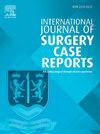Small intestinal obstruction caused by the gastric bezoars in elderly diabetic patients: A case report
IF 0.6
Q4 SURGERY
引用次数: 0
Abstract
Introduction
Bezoar is an unusual cause of small bowel obstruction accounting for 0.4–4 % of all mechanical bowel obstruction. With the rising incidence of diabetes and the associated risk of gastrointestinal issues.
Case presentation
A 59-year-old female diabetic patient with no prior surgical history presented with severe nausea, vomiting, and abdominal pain. CT scan revealed dilated small bowel loops, and endoscopy showed gastric retention with an impacted fecalith in the descending duodenum. At exploratory laparotomy, a bezoar was found impacted in jejunum 5–6 in. away from the Treitz ligament and was removed through an enterotomy.
Clinical discussion
The discussion highlights the rarity of bezoar-induced small bowel obstruction and the diagnostic challenges it presents. Despite its low incidence, it is essential to consider phytobezoars in the differential diagnosis of small bowel obstruction, especially in middle-aged to older adult diabetic patients. The case underscores the importance of a detailed patient history and the use of imaging modalities such as computed tomography (CT) for accurate diagnosis. Early intervention is critical to prevent serious complications like bowel ischemia or perforation. When conservative treatments are ineffective, surgical intervention becomes necessary.
Conclusion
Bezoar-induced small bowel obstruction remains an uncommon diagnosis. A detailed patient history and appropriate imaging are vital for timely diagnosis. It should be suspected in patients with an increased risk of bezoar formation, such as in middle-aged to older adult diabetic patients or a history suggestive of increased fiber intake. CT scan is helpful for preoperative diagnosis. and highlights the need for increased awareness among clinicians regarding the management of bezoars.
老年糖尿病患者胃牛黄致小肠梗阻1例。
牛黄是引起小肠梗阻的罕见原因,占所有机械性肠梗阻的0.4- 4%。随着糖尿病发病率的上升和相关的胃肠道问题的风险。病例介绍:59岁女性糖尿病患者,无手术史,表现为严重恶心、呕吐和腹痛。CT扫描显示小肠袢扩张,内窥镜显示胃潴留并十二指肠降部阻生粪石。剖腹探查时,发现空肠5-6英寸内嵌有牛黄。并通过肠切开术切除。临床讨论:讨论强调牛粪引起的小肠梗阻的罕见性和它提出的诊断挑战。尽管发病率很低,但在小肠梗阻的鉴别诊断中,特别是中老年糖尿病患者,考虑植牛黄菌是必要的。该病例强调了详细的患者病史和使用计算机断层扫描(CT)等成像方式进行准确诊断的重要性。早期干预对于预防肠缺血或穿孔等严重并发症至关重要。当保守治疗无效时,手术干预是必要的。结论:牛粪引起的小肠梗阻仍然是一种罕见的诊断。详细的病史和适当的影像学检查对于及时诊断至关重要。应怀疑牛黄形成风险增加的患者,如中老年糖尿病患者或有纤维摄入增加史的患者。CT扫描有助于术前诊断。并强调需要提高临床医生对牛黄管理的认识。
本文章由计算机程序翻译,如有差异,请以英文原文为准。
求助全文
约1分钟内获得全文
求助全文
来源期刊
CiteScore
1.10
自引率
0.00%
发文量
1116
审稿时长
46 days

 求助内容:
求助内容: 应助结果提醒方式:
应助结果提醒方式:


